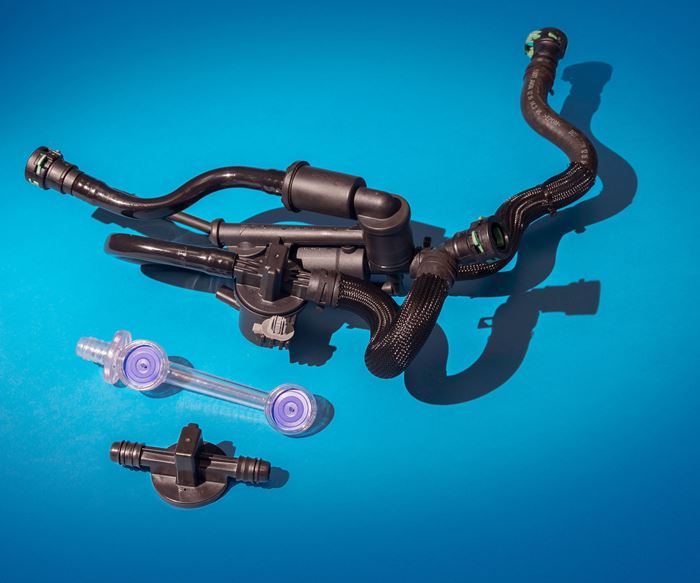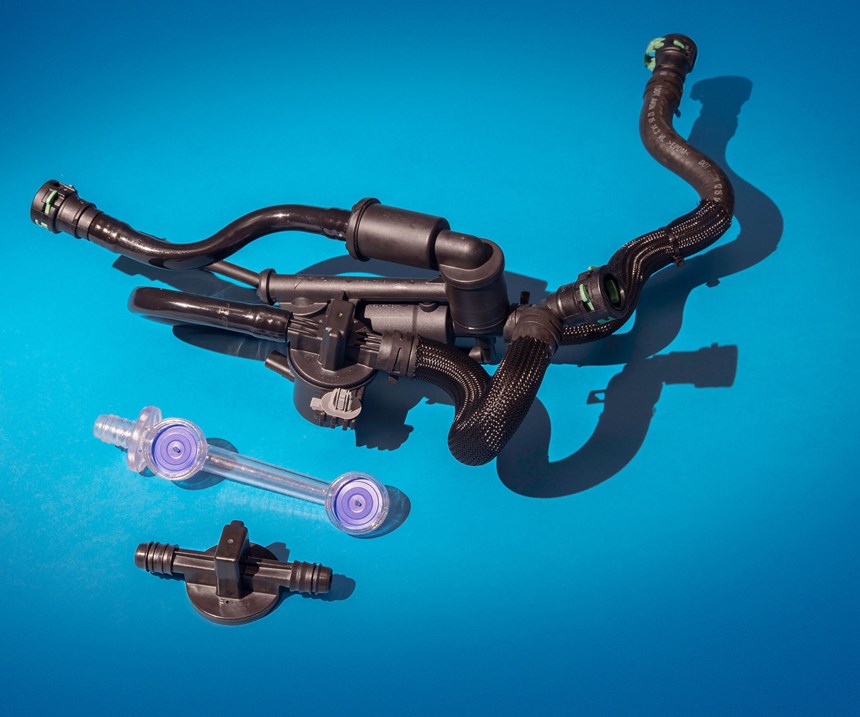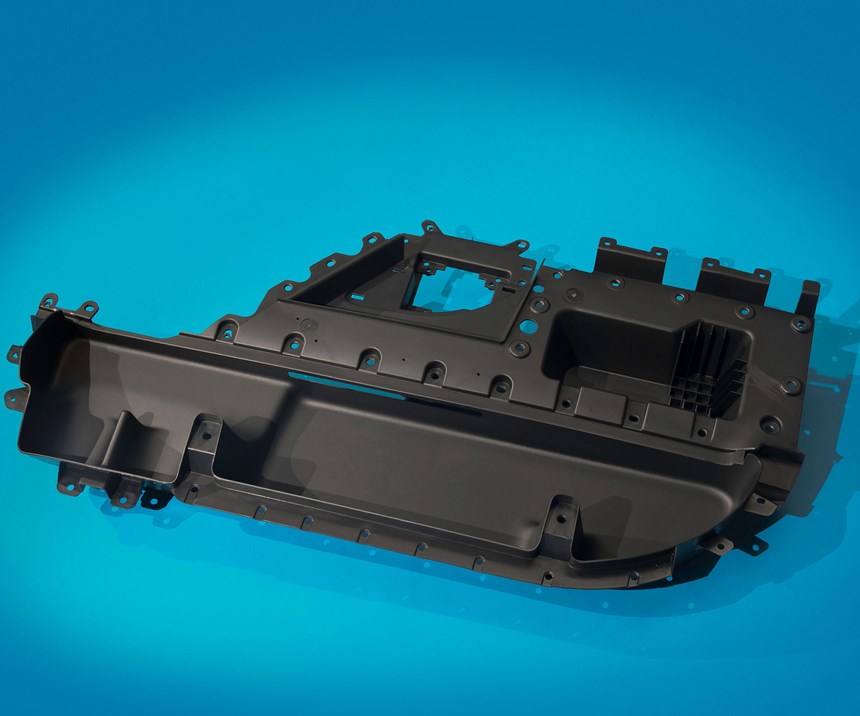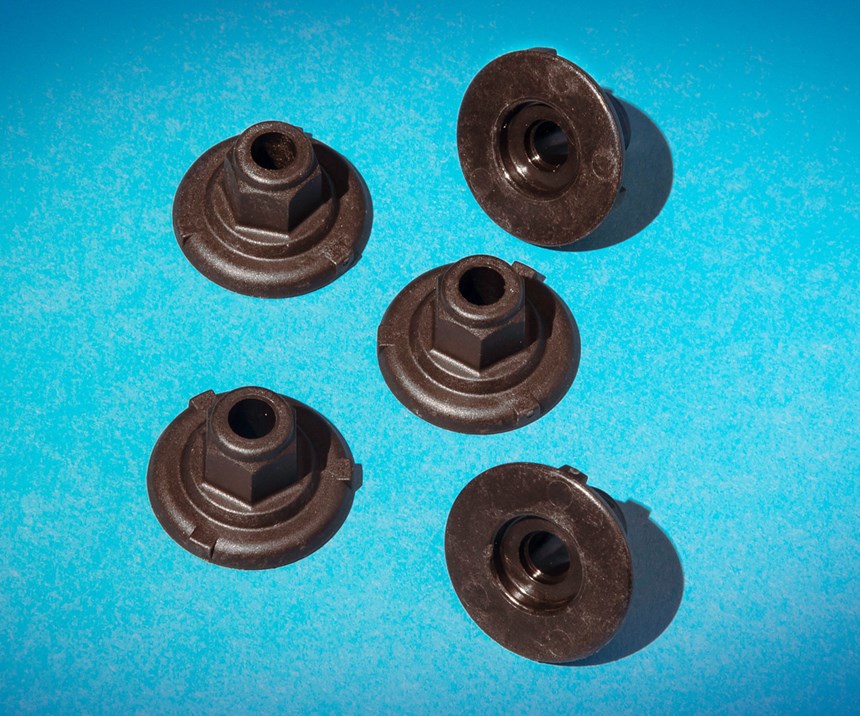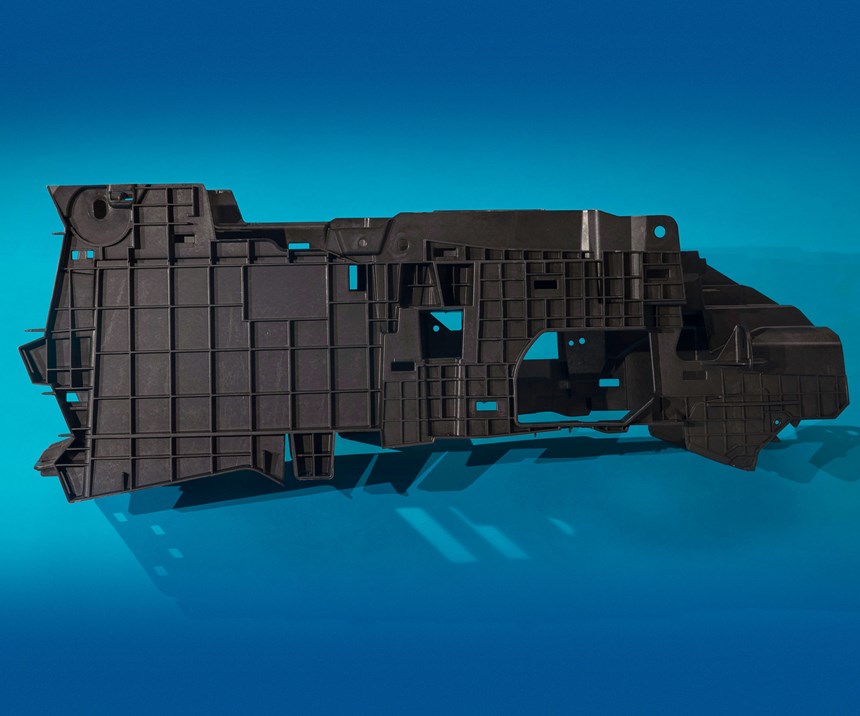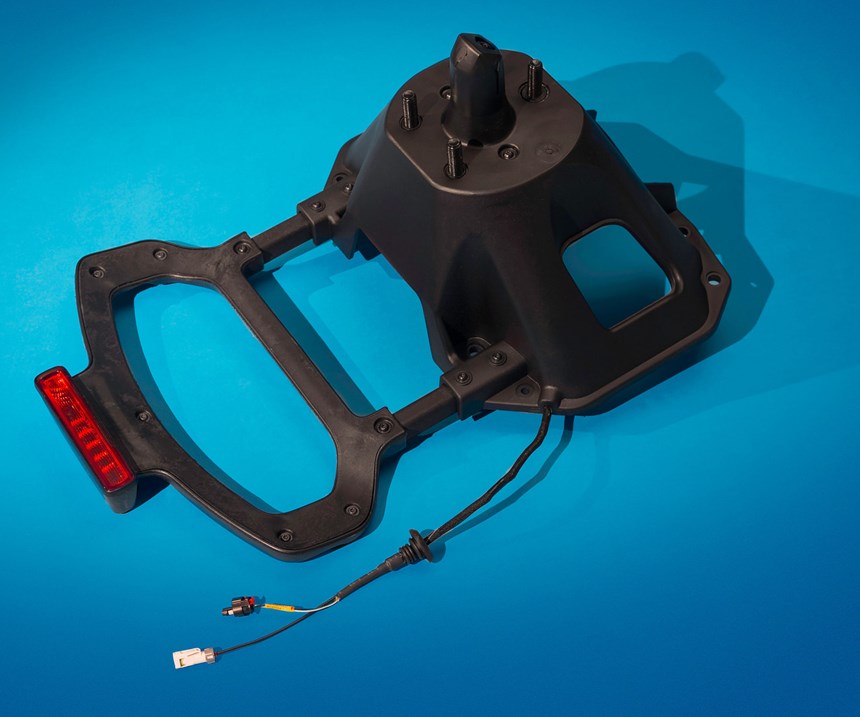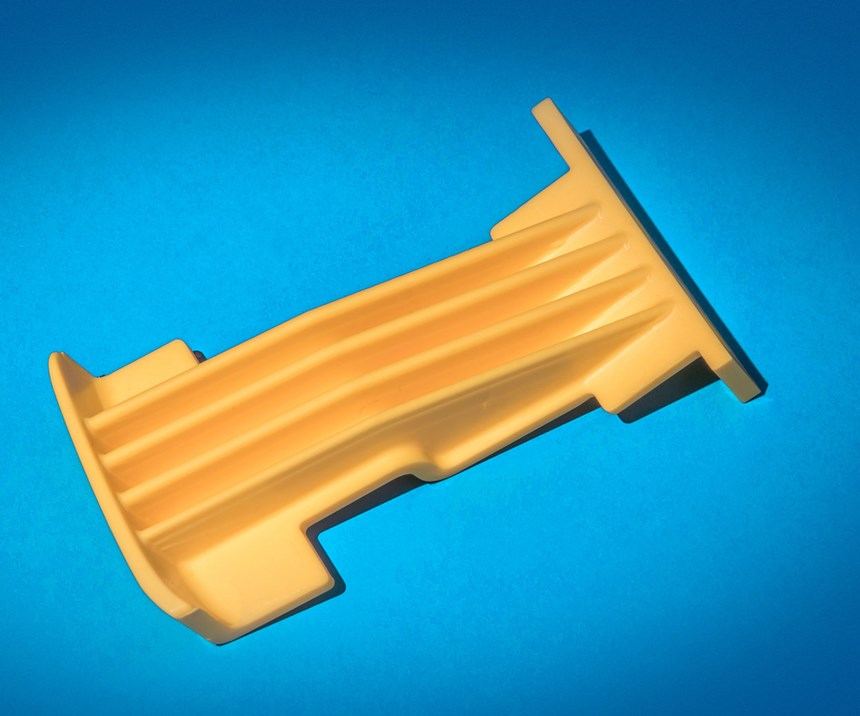Several Thermoplastic 'Firsts' Among 2018 SPE Automotive Awards
With the addition of an Additive Manufacturing slot, all nine categories exemplify innovation and transferability in the use of plastics.
Spanning nine categories, including one newly added for Additive Manufacturing, the Society of Plastics Engineers Automotive Division’s 2018 Blue Ribbon Automotive Innovation Awards (which this editor helped judge) represented a number of “firsts” in either metal replacement or replacement of earlier plastics solutions with better options. In this 48th annual competition, the oldest and largest competition of its kind globally, thermoplastics and/or thermoplastic composites ruled. Here’s a look at the winners, starting with the grand winner award—also the winner of the Powertrain category.
POWERTRAIN: VACUUM GENERATION SYSTEM FOR BRAKE ASSIST
The open/close valve-actuation system made its debut in the 2017 Ford F-150 pickup, and was designed and supplied by Tier One supplier Dayco Products and molded by MacLean-Fogg’s Engineered Plastics unit. The system utilizes two complimentary resin systems from DuPont Automotive—Delrin 73M30 acetal with PTFE, and Minion 520MP mineral-filled nylon 6—which together prevent “stick-slip” and result in no measurable wear after 2.5 million hot/cold test cycles. A 40% weight savings and a 25% cost savings over current pump systems was achieved.
This application is transferrable to other Ford platforms and is being considered by other car companies.
ADDITIVE MANUFACTURING: WINDOW ALIGNMENT FIXTURE
This fixture appears in the 2017 Ford Mustang convertible and was produced by Stratasys using its Fused Deposition Modeling (FDM) system and nylon 12 with 35% short carbon fiber. The fixture integrates pneumatic control, eyelets for a stowage rack, trigger-switch housing, ergonomic handles, gauge-protector deflector and pneumatic-tubing retainers and switch mounts. This unit is 30% lighter and cheaper to produce than a traditional welded fixture. It is also much faster to manufacture—taking only 50 hr to build the integrated fixture with handles and mounting brackets. Moreover, ergonomics reportedly were improved significantly. The plastic fixture allows for easier handling and avoided the requirement for a lift assist.
BODY EXTERIOR: THERMOPLASTIC LIFTGATE
This liftgate appears in the 2019 Fiat Chrysler’s Jeep Cherokee SUV, and was molded by Magna International’s Magna Exteriors business. It’s injection molded from Trinseo’s DLGF 9411, a 40% long-glass PP with good flow properties, and Lyondell Basell’s Hifax TYC, a very high-flow TPO containing 30% glass. The integrated tethering attachments are molded in glass-filled nylon. Replacing a steel liftgate with a thermoplastic design enabled a 28% weight reduction and a 50% savings in tooling and capital investment through part integration and manufacturing efficiency.
An industry-first use of conformal infrared welding behind the MIC (molded-in-color) grain class A surface increased structural and dimensional performance and enabled quicker processing. Bonded brackets enabled novel tethering attachments without fasteners, improved metal reinforcement efficiency, and maintained styling surface wrap in D pillars without sacrificing DLO. All this was accomplished within an 18-month window.
BODY INTERIOR: INTEGRATED MODULAR PELVIC BOLSTER
This application appears on the 2018 Ford Lincoln Navigator SUV and is molded by Faurecia Interior Systems from LyondellBasell’s Profax SX702, a high-flow, high-impact PP copolymer. The unit combines two unique side-impact bolster designs. Integrating them into the map packet resulted in tooling cost savings estimated at $100,000. There was an additional $100,000 indirect savings in testing time and $8 per vehicle cost avoidance vs. using add-on bolsters. An approximate 10% weight savings was achieved.
CHASSIS/HARDWARE: HIGH-STRENGTH, SELF-TAPPING COMPOSITE NUT
This appears on the 2016 Fiat Crysler Pacifica minivan and is molded by ITW Deltar Fasteners from Asahi Kasei Plastics’ Leona 90G55, a 55% glass-filled nylon 66. This composite nut has self-healing properties, enabling it to maintain sufficient torque and clamp load even after it has been stripped, unlike the metal nut that it replaces.
Total mass savings is 8 g per location x 121 locations, for a total vehicle mass savings of 2.1 lb for this vehicle. Estimated cost savings per vehicle is $3.25. The composite nut can be translated across all OEMs and in many additional applications.
ENVIRONMENTAL: SUSTAINABLE HYBRID COMPOSITES
This center console carrier appears in the 2018 Ford Lincoln Continental luxury sedan and is an industry-first application of composites combining cellulose fiber from trees with long-glass fiber (LGF) in PP to replace 35% short-glass/mineral-filled PP. It used International Paper’s Thrive cellulose composite made with Celanese’s Celstran PP+HC, containing LGF and continuous glass fiber with PP and recycled PP. Melt compounding was followed by injection molding by Tier One Summit Polymers. A 24% weight savings and a 13% cost savings were realized. A total of $2 million cost savings resulted from reducing weight and reducing cycle times by 20& to 40%. This is said to be the largest single automotive part thus far that is made with sustainable plant-based composite materials.
MATERIALS: EMI SHIELDING COMPOUNDS FOR HIGH-VOLTAGE COVER
This application debuts on the 2019 Hyundai Nexo SUV. It is made of a new conductive plastic compound from Hanwha Compound, developed specifically for EMI shielding of high-voltage junction-box upper covers. Injection molded by Yura Corp., it is made of Hanwha Compound ESM-204B nylon 6/PPO compound with hybrid conductive carbon filler (carbon fiber, nano-carbon fiber/carbon nanotubes, and carbon black). The material, which contains no metal powder or metal-coated fiber, replaces conventional die-cast aluminum covers for reduced weight and manufacturing costs. Weight savings are estimated at 30% (0.3 kg) and cost savings are estimated at 70% ($50 per vehicle.)
PROCESS/ASSEMBLY/ENABLING TECHNOLOGIES: INTEGRATED TIRE CARRIER, REAR CAMERA & BRAKE LIGHT
This appears on the 2018 Fiat Chrysler Jeep Wrangler SUV. Its hybrid composite technology utilizes Legerra Technologies’ injection molded magnesium (thixomolding) and TMD-Grammer AG’s overmolding with DuPont’s Zytel ST 801 AW, an unreinforced, super-tough nylon 66. It is said to offer higher structural strength with reduced weight and improved impact and corrosion resistance.
Weight savings are 60% vs. metal stamping and 20% vs. die casting. Cost savings are 20% with an improved load rating from 85 to 115 lb. The new design also eliminates the need for a steel bracket.
SAFETY: INTERLOCKING MECHANISM DESIGN FOR SIDE IMPACT
This debuts in the 2019 Ford Transit Connect van. It was designed and molded by Furecia Interior Systems and Thermolympic SL using Trinseo’s Magnum 3325MT, a medium-heat ABS with low gloss and high flow. This interlocking mechanism improves door-trim performance during side impacts by preventing fracture or separation of components that could leave sharp edges.
This design provides strong attachments, force absorption, and high impact resistance between two components during side impact. It replaces the need for metal brackets, saving 3.70 kg per vehicle. Cost avoidance of $30.60 per vehicle and tooling-cost savings of $9.88 million were achieved, along with 3.7 kg vehicle weight saving.
Related Content
Improving Twin-Screw Compounding of Reinforced Polyolefins
Compounders face a number of processing challenges when incorporating a high loading of low-bulk-density mineral filler into polyolefins. Here are some possible solutions.
Read MoreIn Sustainable Packaging, the Word is ‘Monomaterial’
In both flexible and rigid packaging, the trend is to replace multimaterial laminates, coextrusions and “composites” with single-material structures, usually based on PE or PP. Nonpackaging applications are following suit.
Read MoreFirst Quarter Looks Mostly Flat for Resin Prices
Temporary upward blips don't indicate any sustained movement in the near term.
Read MoreFundamentals of Polyethylene – Part 6: PE Performance
Don’t assume you know everything there is to know about PE because it’s been around so long. Here is yet another example of how the performance of PE is influenced by molecular weight and density.
Read MoreRead Next
Lead the Conversation, Change the Conversation
Coverage of single-use plastics can be both misleading and demoralizing. Here are 10 tips for changing the perception of the plastics industry at your company and in your community.
Read MoreRecycling Partners Collaborate to Eliminate Production Scrap Waste at NPE2024
A collaboration between show organizer PLASTICS, recycler CPR and size reduction experts WEIMA and Conair will seek to recover and recycle 100% of the parts produced at the show.
Read More

